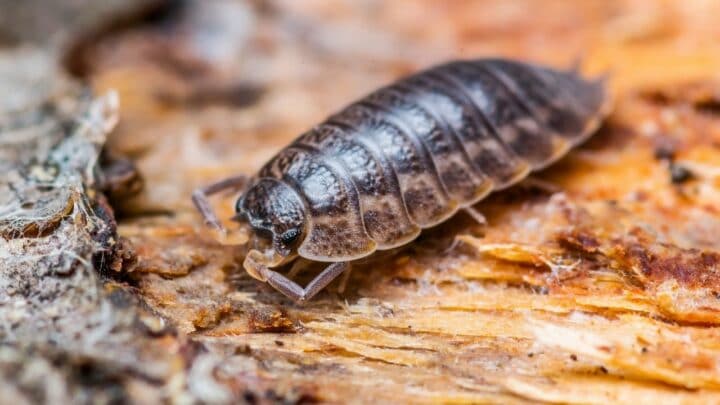Isopods are a class of invertebrates with thousands of species that can be found on both land and sea.
While the first thing that comes to mind when identifying them is that they look like insects, the genetic markup of isopods is closer to the crustation family.
As they are terrestrial isopods, they are the only crustaceans that can be fully terrestrial, living predominantly on land. There are also larger isopods.
These are aquatic isopods and live in water environments or close to shore.
Unless you look closely, the mouth on isopods is not immediately visible. The body of an isopod is simple.
It is broken into three areas, the head, thorax, and abdomen. Depending on the isopod type, their body size varies.
Do Isopods Bite?
Some isopods do bite. Terrestrial isopods do not bite, while aquatic isopods do. While many of the species of isopods are scavengers, there can be several organic materials that attract each species.
Do Terrestrial Isopods Bite: The Answer
Terrestrial isopods such as rolly polys, pillbugs, sowbugs, woodlice, do not pose a threat to humans.
Their diet consists predominantly of decaying greenery, including decaying or decomposed plants, plants, grasses, and weeds.
As such, they are not genetically designed to consume tougher materials. This is why they pose no better risk to humans.
The terrestrial isopod’s response, when threatened, is not to fight back in the form of biting or stinging, but to curl into tight balls, which is where the name rolly poly originates.
Aquatic Isopods and their Biting Tendencies
Unlike their landlocked relatives, aquatic isopods are scavengers, omnivores, and herbivores.
The common food sources that they consume are decaying plant and algae material, dead animal matter, and small organisms that live on underwater rocks or in the sand. Because of their diet, their mouth is designed for chewing and breaking down organic material.
The way that aquatic isopods feed is through a method that leaves animal carcasses picked clean. They travel in large groups, or swarms, with the power in their jaws and relentless eating.
They can come across a dead whale and only leave a skeleton behind.
Even though this may sound alarming, aquatic isopods are not aggressive eaters or hunters. While they can bite humans, they do not pose a danger.
Aquatic isopods are more likely to bite when they believe they are being presented with a meal.
Like terrestrial isopods, they also curl up towards threats. Their hard exoskeleton protects them from underwater predators.
Aquatic Isopod That Has The Strongest Bite
The strongest bite power is awarded to the giant isopod. They live at depths between 550 and 7000 feet below the ocean.
The giant isopod does operate as a carnivorous scavenger, feeding on the decomposing carcasses of animals.
With their size and stronger bite, they will also feed on small and slow-moving live organisms beneath the water.
What makes them have the most powerful bit of aquatic isopods is their four jaws. Lined with razor-sharp teeth, these are designed to allow for the isopod to tear at either scavenged carcasses or live prey.
While their bite is from tearing apart small organisms and decomposing animals, a bite on a human would be felt but is very minimal.
Aquatic Isopods That You Can Find on the Shore
Cirolanid isopods, more commonly known as sand fleas or sand lice, live close to the shores of beaches. They also move further up on the shore when the tide rises and the sand is damp.
One might encounter swarms of sand fleas on a night beach trip.
Unlike terrestrial isopods, these bear a strong resemblance to either crustaceans or a common pace land flea. They can effectively ruin a beach experience just by their serious numbers.
They also are capable of making small bites.
While these bites can draw blood, they produce more of an itching sensation rather than pain.
Sand fleas are not poisonous to humans and their main food source is achieved through scavenging dead and decomposing animals.
Frequently Asked Questions About Isopod Bites
Are isopod bites poisonous?
Terrestrial isopods are not poisonous to humans, as they do not sting or bite. Rather than posing as a treat, they are more of a general nuisance when keeping them out of garden areas. Aquatic isopods also are not poisonous when they bite.
Do aquatic isopods attack divers?
Aquatic isopods are not aggressive. While they are strong swimmers and usually travel in groups, they do not actively hunt live prey. When presented with something that they believe is food and is slow-moving, they may bite.
Where are you most likely to be bit by an isopod?
Bites can happen on the beach and in the shallow waters. While rare, there have been instances where the isopods leave several small bites that draw blood. It is far more commonplace to be bit by isopods being raised in captivity when offering food.
In Conclusion
Terrestrial isopods cannot bite humans and thus pose no danger. Many people also keep them in terrariums as pets.
While aquatic isopods are capable of biting, it is not a commonplace instance for them to actively seek out and bite humans. So while some varieties of isopods can bite, they are not a danger to humans.


